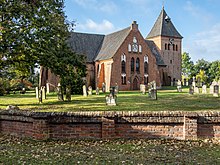Langwedel
Langwedel | |
|---|---|
Location of Langwedel within Verden district  | |
| Coordinates: 52°58′N 9°13′E / 52.967°N 9.217°E | |
| Country | Germany |
| State | Lower Saxony |
| District | Verden |
| Subdivisions | 6 districts |
| Government | |
| • Mayor (2017–25) | Andreas Brandt[1] (SPD) |
| Area | |
• Total | 76.12 km2 (29.39 sq mi) |
| Elevation | 19 m (62 ft) |
| Population (2022-12-31)[2] | |
• Total | 14,654 |
| • Density | 190/km2 (500/sq mi) |
| Time zone | UTC+01:00 (CET) |
| • Summer (DST) | UTC+02:00 (CEST) |
| Postal codes | 27299 |
| Dialling codes | 04232, 04235 |
| Vehicle registration | VER |
| Website | www.langwedel.de |
Langwedel is a municipality in the district of Verden, in Lower Saxony, Germany. It is situated on the right bank of the Weser, approx. 7 km northwest of Verden, and 30 km southeast of Bremen.

Langwedel belonged to the Prince-Bishopric of Verden, established in 1180. In 1648 the Prince-Bishopric was transformed into the Principality of Verden, which was first ruled in personal union by the Swedish Crown - interrupted by a Danish occupation (1712–1715) - and from 1715 on by the Hanoverian Crown. The Kingdom of Hanover incorporated the Principality in a real union and the Princely territory, including Langwedel, became part of the new Stade Region, established in 1823.
Organization
Langwedel is a unit municipality and consists of the following villages:
- Daverden (13,005 km2).
- Etelsen (with Cluvenhagen and Hagen-Grinden as well as Giersberg and Steinberg).(23,874 km2)
- Haberloh (5,404 km2).
- Holtebüttel (with Dahlbrügge, Nindorf, Schülingen and Overing and Förth) (8,492 km2).
- Langwedel (with Langwedelermoor) (7,619 km2).
- Völkersen (17,716 km2).
References
- ^ "Verzeichnis der direkt gewählten Bürgermeister/-innen und Landräte/Landrätinnen". Landesamt für Statistik Niedersachsen. April 2021.
- ^ "LSN-Online Regionaldatenbank, Tabelle A100001G: Fortschreibung des Bevölkerungsstandes, Stand 31. Dezember 2022" (in German). Landesamt für Statistik Niedersachsen.




